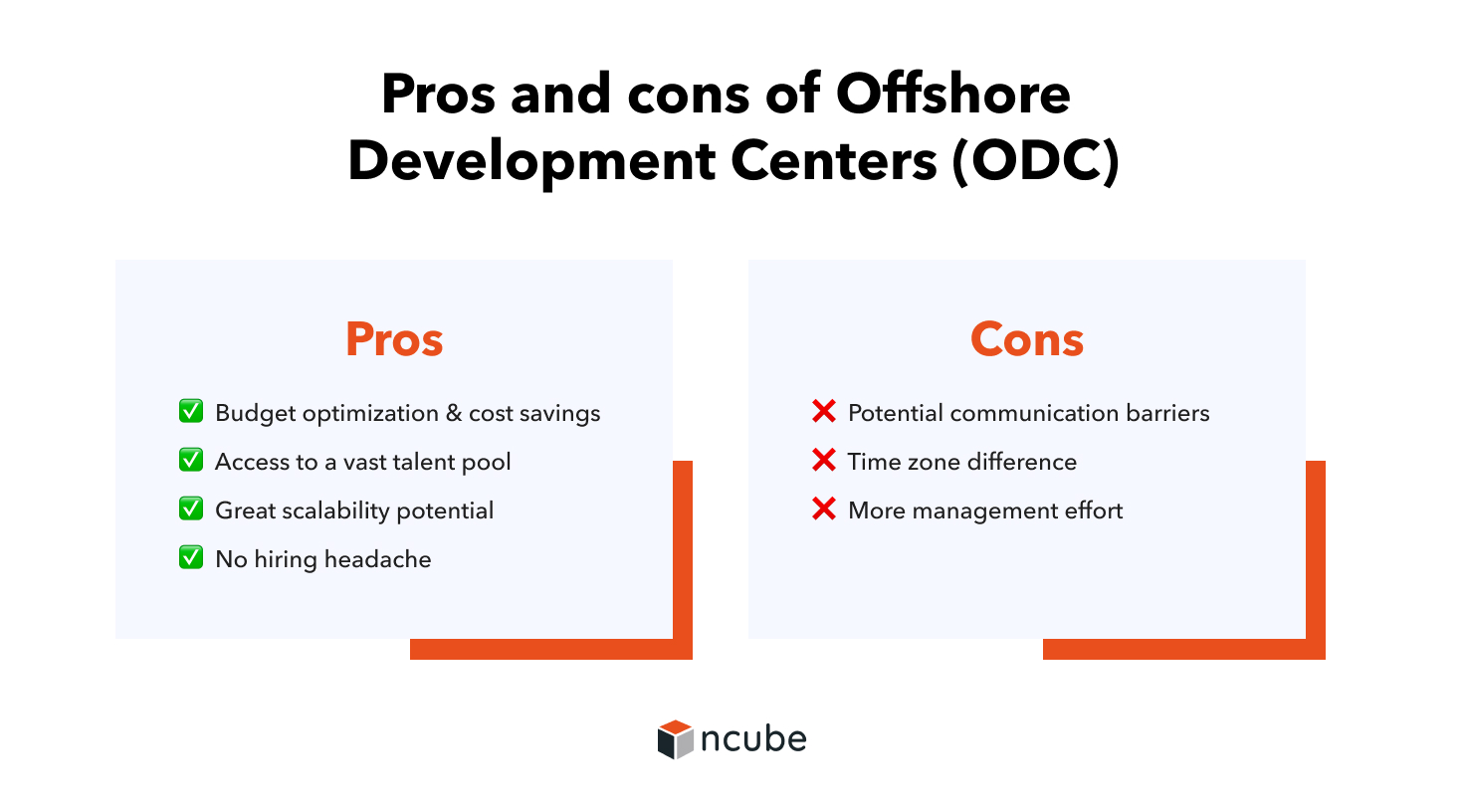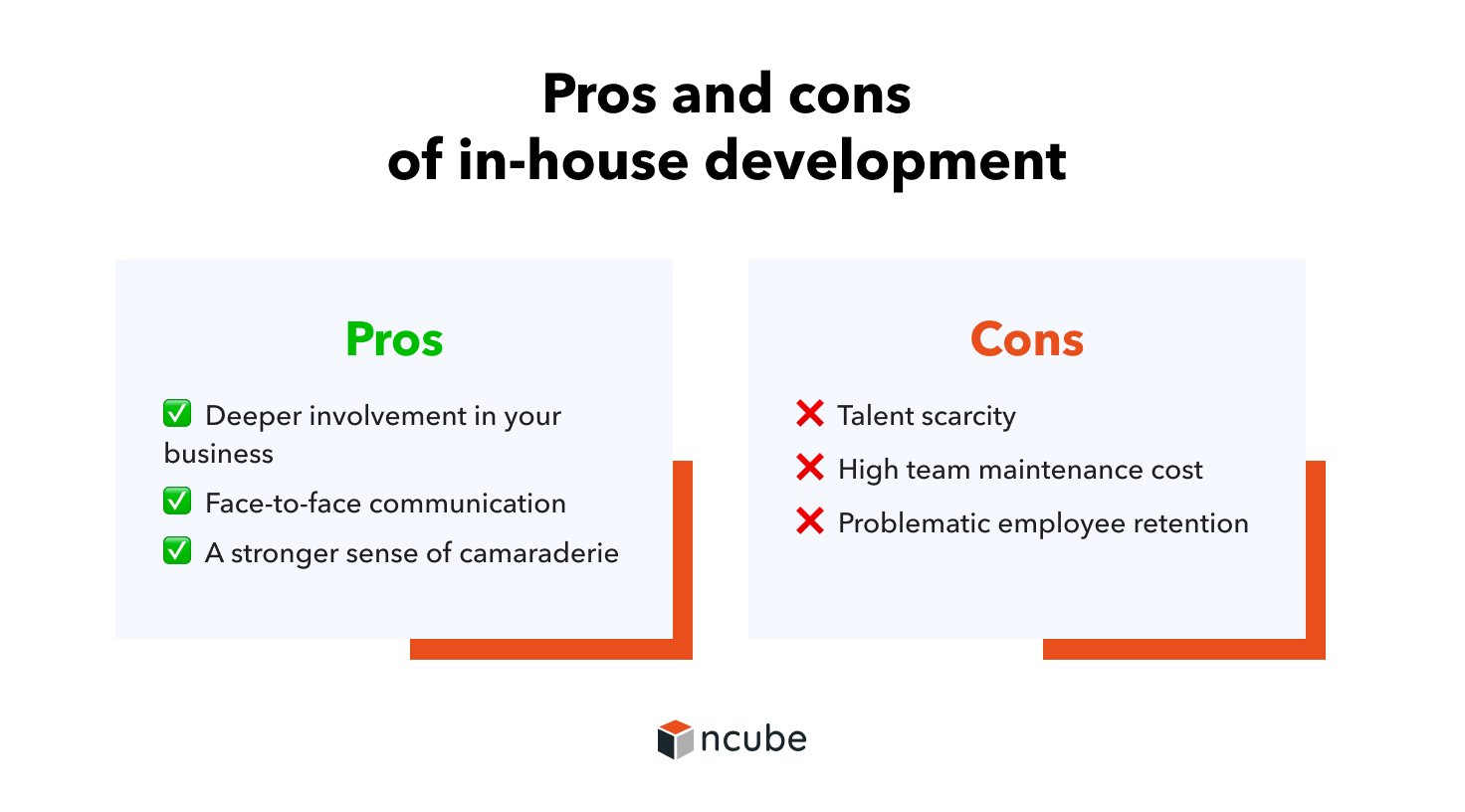
Offshore Development Center vs. In-House Team: Which one is Best for You?

If you’re reading this post, you’re probably wondering if it’s worth building an offshore development center vs. an in-house one. As a provider that augments our clients’ in-house software development units with remote tech talent, we’ve seen the best of both worlds. In this post, we’ll shed light on both options so that you can make an informed decision.
If you have a software idea, the reasonable question is how you will turn it into a reality. In many scenarios, it’s not even a question of how you will develop but who is going to work on it. The question of offshore development center (ODC) vs. in-house squads starts with realizing that your local talent pool no longer limits you. Instead, in the connected world we live in, you can assemble an ODC remote center consisting of talented people scattered worldwide and work with them virtually as if they were next door.
In fact, 58% of companies, as per Gartner research, have tech talent working across national borders.
Let’s see how the offshore development centers vs in-house development battle stack up when it comes to various parameters.
Criteria | In-house development | Offshore Development Center (ODC) |
| Location | On-premises, without the help of external resources | Remote, often in offshore zones like Eastern Europe or Latin America |
| Cost | Higher costs due to expenses associated with permanent staff and overhead | Cost-effectiveness due to zero overhead and employee benefits, as well as lower software development rates |
| Control | The client has direct, immediate control | The client has direct control but at a distance |
| Talent availability | Limited to the local pool of tech talent | Access to a global pool of tech talent |
| Scaling | Limited scaling potential due to local talent pool scarcity | Flexible scaling due to larger pools of talent |
| Communication | Implies the benefit of face-to-face communication | Possible communication challenges due to time zone differences and language barriers |
| Management | Simpler control and engagement due to closer proximity | Managerial effort required to ensure smooth team synchronization |
| Culture | Easier to build a unique company culture | Effort required to instill culture due to a remote setting |
Now, let’s dive in and take a closer look at how you can organize the remote software development process.
The concept of an ODC remote center
In today’s world, we are all familiar with the concept of working remotely, but working remotely and having an actual ODC remote center can be vastly different things. Our model at nCube aims to build an ODC remote centre that will act as an extension of your in-house development unit, as in being fully dedicated to your project, following your company’s workflow, and communicating with you directly. At the same time, you’ll stay in control of the remote development process.
Many companies delegate the task of building an ODC remote center to providers that specialize in setting up teams in a particular region. For example, we build remote teams of Eastern European and Latin American software developers.
Whether you go with our model or decide to build an ODC remote center yourself, we want to show you the benefits and downsides of this solution.
ODC Benefits
Budget optimization. The question of an offshore development center vs. an in-house department often comes down to cost. Although building a remote team requires a lot of effort, especially if you do it on your own, that effort can be warranted by affordability. It’s common knowledge that a remote workforce is cheaper than hiring in-house development staff, as you can save on overhead. If you choose our model, you’ll get even more coverage, given that we as a provider take care of IT infrastructure, office space, insurance, HR support, employee motivation, team building, and more.
A vast talent pool. This is one of the biggest benefits of ODC: It allows companies to access a variety of skills, both general and niche ones. More so, many remote developers are on par or exceed many companies’ local markets in terms of skills. Another significant benefit that comes with it is that it takes less time to bump into seasoned specialists. This way, you can build an ODC remote center on short notice. The pool of talent we rely on exceeds the 2 million software engineers available in Eastern Europe and Latin America, which lets us source skilled engineers quickly.
Scalability. Another ODC benefit is that working with a partner like us gives you the flexibility to add, remove and replace staff at will, so you can be more pragmatic and never compromise when it comes to your project needs. Compared to an in-house software development unit, it’s much easier to move resources around in an ODC remote center and even build a team faster. For example, at nCube we set up a typical tech team in 2-4 weeks for an offshore development center vs. in-house which takes less time than building a home-based squad.
Simple hiring. Going for an ODC remote center allows you to forget about the hassle of vying for the top talent with tech giants in your home market. More so, if you partner with a vendor who has expertise in building a tech unit (similar to what we do at nCube), they will pre-select employees according to your ideal candidate profile, so you don’t have to wade through tons of resumes each time you need to backfill a vacancy.
Downsides of ODC remote centers
Communication barriers and time zone. Although external employees usually vibe well with in-house development staff, there may be some challenges related to time zone differences and language barriers. However, if you partner with the right vendor, those can be alleviated and even turned to your benefit. For example, if you’re based on the East Coast and hire specialists from Eastern Europe for remote development, you will get a lot of coverage, given that they are 7-8 hours ahead of you. Thus, coupled with your in-house software development staff, you’ll get people pushing your project forward around the clock. The downside here is that, with an ODC remote center, it always comes down to the proper management, which sometimes can be laborious.
Management difficulties. Although your remote employees know they work for you (and your brand), it can be problematic to gauge their commitment and loyalty. Let’s be honest: it’s hard to know how your workers feel when you’re separated by distance. Thus, the question of personal engagement of a team member may arise, which can be rectified by regular surveys and one-on-one meetings, just as you do with your in-house software development specialists.

What is in-house development?
An in-house software development squad is an internal company unit assembled to handle a specific project on the company’s premises. Traditionally, in-house development staff is co-located. However, now that most in-house units have gone with remote work, the term “co-located” has lost its meaning since team members aren’t tethered to the office anymore.
One of the reasons why leaders choose to hire an in-house team is the notion that remote team members are only productive when they are physically present at the office. Another reason is the need to build a team for the core activity that requires close cooperation between all team members, for example, at the start of the project. Let’s take a look at the pros and cons of an in-house team.
Pros of in-house development
A deeper understanding of the inner workings of your business. An in-house software development unit typically accumulates knowledge about your company, domain, market, etc. Thus, it has a lot of business acumen that can be applied to product development, which can be hard to achieve when team members are scattered around the globe.
Face-to-face communication. When everyone is inundated with emails and chats, which is typical for distributed communication, there is a chance your staff might miss something important. As such, the benefit of face-to-face communication definitely speaks in favor of in-house development teams.
With this in mind, if it’s vital for your business to make decisions fast, an in-house development workforce offers a shorter feedback loop and a quicker approval process facilitated by face-to-face communication. When a team works in-house, it’s easier to stay on top of what they are currently working on and shuffle their priorities at hand. Co-located staff is also better positioned to respond to emergencies, given that they operate in the same time zone.
That’s not to say that ODC remote centers can’t provide the same level of control and communication. It’s just that it takes managerial effort to establish stable communication processes. We at nCube help our customers with that, and to that end provide our teams with everything needed for solid communication, including equipped meeting rooms and modern IT infrastructure.
Team spirit. Although it takes a lot of effort to build a strong company culture, in-house software development teams exhibit a sense of camaraderie, which can be put to good use in building strong communication, mentorship, and day-to-day work. As a result of strong chemistry, employees can remain creative, passionate, and productive.
Downsides of in-house development
Talent scarcity. Gathering all the needed experts in one place can be challenging. The demand for good developers is at an all-time high, making it much harder to find the needed skills locally. You can overcome this difficulty with an ODC remote center. If you choose to partner with a provider that builds such centers (for example, nCube), the weight of recruitment will be carried by the partnering company of your choice. You will only need to interview and approve the pre-selected candidates.
READ ALSO: Software Engineer Shortage in the World
High cost. ODC remote centers have the upper hand over in-house development teams in terms of cost-effectiveness. Running a local unit, the employer covers health insurance, days off, IT infrastructure, severance pay, and other benefits. Moreover, when a project is at a standstill, having a team of full-time employees can also strain your budget.
Huge investment. It takes time and resources to keep people happy. In light of high demand, software developers tend to change the working place quite often. Finding new developers is always time-consuming when a dozen other companies are vying for tech talent. As a result, you may face some challenges with finding replacements and therefore lose precious time.

ODC or in-house development: How to choose?
If you’re still weighing offshore development center vs. in-house, we should admit that both models have their benefits and shortcomings, but at the end of the day, the choice depends on your company’s needs. Before diving in, you might want to consider deadlines, budget, and your management experience. To sum it up, here are the typical scenarios for the two options.
When to go with an ODC remote center:
- You are looking for ways to optimize your budget by trimming unnecessary expenses;
- You need to add a set of rare skills to your unit you can’t find locally;
- You want to scale the team up and down, depending on your project needs;
- You want to speed up the recruitment process.
When to go with in-house software development:
- Building a close-knit team and a one-of-a-kind company culture is crucial for you;
- It’s key to keeping all expertise in-house;
- Your project is at an initial stage where face-to-face communication is vital;
- You lack experience in remote software development and management.
How to start a remote development team with nCube
Select the location of your offshore development team. In this day and age, it’s possible to launch a remote software development team anywhere in the world. However, certain regions can be more advantageous than others. For instance, you may want to build a nearshore or offshore development team. For that, it’s best to consider such regions as Eastern Europe and LATAM – both regions can suit you best, depending on your location.
Are you located in the USA? Then Eastern Europe will be your ideal location for an offshore development team thanks to its reputation for a vast talent pool with a diverse range of skills and innovation-oriented software development.
If you’re a US-based company seeking nearshoring opportunities, LATAM can serve as an ideal destination due to its complete workday overlap with North American companies.
For UK and Western Europe-based companies, Eastern Europe stands out as the optimum nearshoring destination. Apart from minimal time zone differences, remote development providers located in this region offer solid knowledge of Western business practices and exceptional cultural proximity.
READ ALSO: Offshore Product Development: Eastern Europe, Latin America or Asia?
Define a suitable collaboration model. Selecting the right collaboration model is vital and depends on your specific requirements and technological needs. You can launch your remote development teams based on the following approaches:

- Staff augmentation
Staff augmentation is an essential collaboration model where you source remote development talent through a provider in your chosen location. With staff augmentation, you will gain access to skilled technologists who work exclusively for your project as if they were members of your internal team. This model offers scalability, cost-efficiency, and the ability to quickly augment your team’s capabilities as needed. For instance, you can add one or several professionals with competencies your team requires, for instance, a QA expert, a front-end developer, a Data Science expert, etc.
- R&D center
If you intend to expand your organization and add a substantial number of employees, including administrative staff, establishing your own R&D center is the recommended collaboration model of remote development. This approach facilitates the setup of a stand-alone offshoot of your remote office, which can become a valuable asset to your organization.
- Dedicated team
If your goal is to build a full-fledged remote software team solely focused on your product, you should select a dedicated remote development team. In this model, you will work with a provider who will assist in setting up and launching a remote team according to your project requirements. The provided team will work under your leadership.
Choose members for your remote development team. The selection process is the centerpiece of the success of your remote software development team. It’s important to remember that remote staff isn’t merely hired hands, but rather an essential extension of your local tech unit.
While you will be guided in your search by your vendor, here are some tips to identify the best remote development professional:
- Assess candidates’ motivation: Along with evaluating technical skills, consider the candidate’s motivation, as in what drives them to join your project.
- Conduct several rounds of interviews: It is advisable to conduct multiple interviews to gain a comprehensive understanding of each candidate. It’s also essential to provide timely feedback as tech talent markets are highly competitive, and candidates may have other options to consider.
- Consider soft skills: While tech expertise is important, don’t overlook the importance of soft competencies. Look for candidates who demonstrate strong communication, teamwork, problem-solving, and adaptability skills that resonate with your existing team dynamics.
The process of building your remote software development teams is a strategic step in the expansion of your organization, so it’s worth investing time and effort. nCube, as a trusted vendor in remote development, can provide valuable assistance in your journey.
Contact us if you’re interested in building an ODC remote center.
Recommended articles


